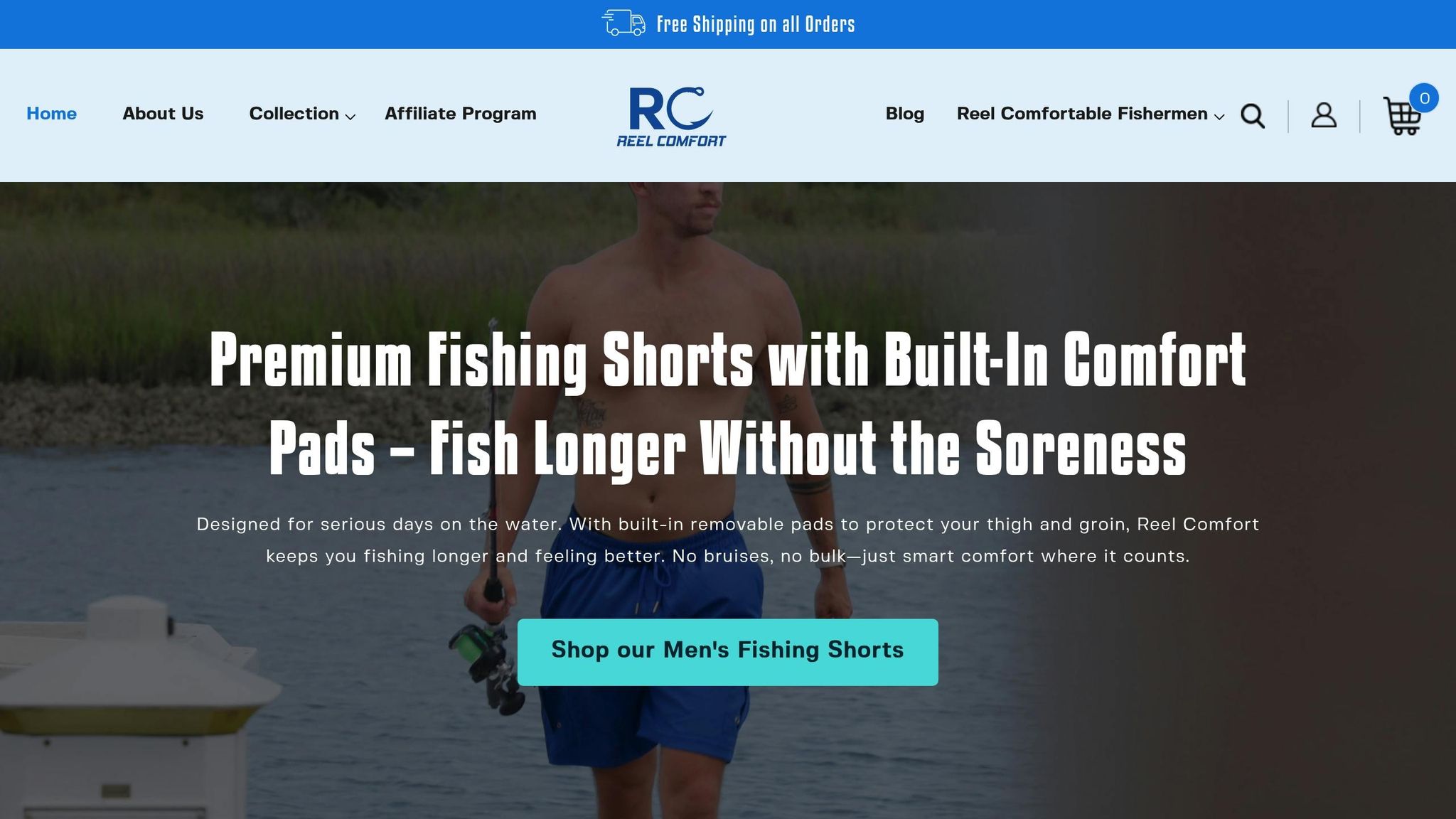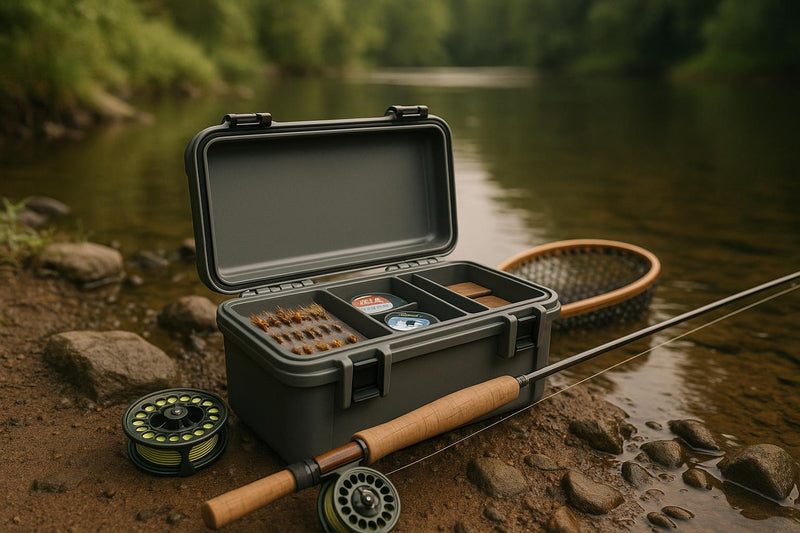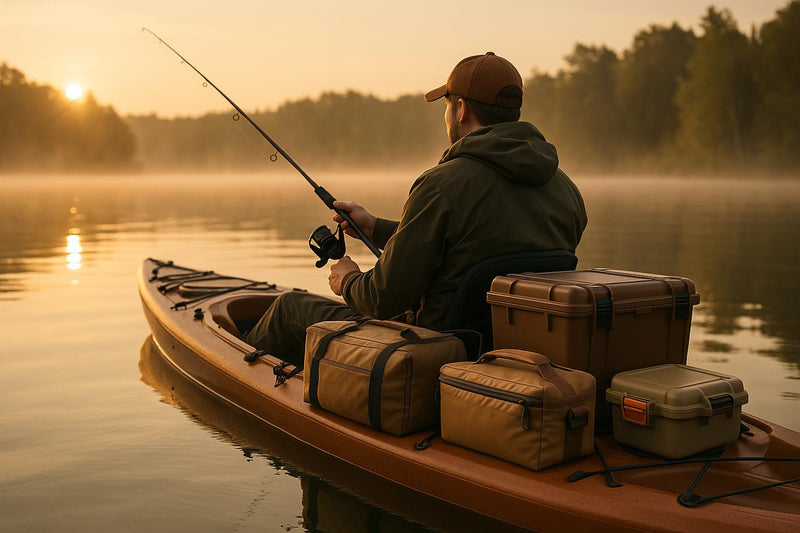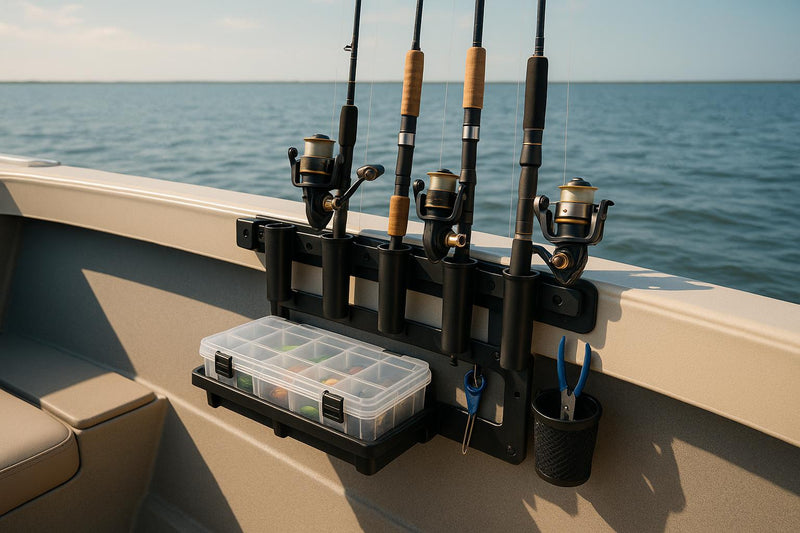When fishing, staying dry is key to comfort and focus. Waterproof fishing shorts, designed with water-resistant fabrics and advanced seam construction, ensure you stay dry in wet conditions. Heat-sealed seams are a standout feature, creating a watertight bond without needle holes, unlike stitched seams. This method keeps water out, boosts durability, and maintains flexibility, making it ideal for anglers. Paired with quick-dry fabrics and practical features like secure pockets and optional thigh pads, these shorts are built for performance. Proper care, like air drying and storing in a cool, dry place, extends their lifespan. Ready for your next fishing trip? Choose shorts with heat-sealed seams for reliable protection and comfort.
How Waterproofing Works in Fishing Gear
Keeping dry while out on the water starts with understanding how waterproofing works. Modern fishing gear uses a combination of specialized fabric treatments and advanced construction techniques to block water while staying breathable and flexible. It’s this balance that makes waterproof gear both functional and comfortable.
Over the years, waterproofing technology has come a long way. What started as basic wax coatings has evolved into sophisticated systems capable of handling hours of rain, spray, or even brief dips in the water. The key is creating a barrier that keeps water out but still allows moisture to escape. This is where seam construction plays a critical role in enhancing waterproof protection.
Water-Resistant vs. Waterproof Fabrics
People often confuse "water-resistant" with "waterproof", but they’re not the same. Water-resistant fabrics provide light protection, repelling moisture and handling brief exposure to rain. Typically, they withstand up to 1,500mm of water pressure, which is fine for light rain but not heavy or prolonged moisture.
Waterproof fabrics, however, take things up a notch. They can endure water pressure of 10,000mm or more, creating a solid barrier against water intrusion. To put that into perspective, sitting on a wet surface can generate about 2,000mm of pressure, while kneeling might add up to 4,500mm. High-quality fishing shorts are designed to handle these pressures without sacrificing comfort or flexibility.
Common Waterproofing Methods
Several techniques are used to make fishing gear waterproof:
- Durable Water Repellent (DWR) coatings: This is the first line of defense. DWR treatments cause water to bead up and roll off the fabric. These coatings bond at the molecular level, creating a hydrophobic layer that can withstand multiple washes.
- Membrane technology: Advanced waterproofing often involves ultra-thin membranes laminated between fabric layers. These membranes have microscopic pores - large enough for water vapor to escape but too small for liquid water to pass through. It’s a great way to achieve waterproofing while maintaining breathability.
- Fabric weave density: Tightly woven fabrics naturally resist water better than looser weaves. This is especially useful in quick-dry fabric technology, where both water resistance and fast drying are essential.
Some designs even integrate waterproofing directly into the fibers with hydrophobic treatments. However, no matter how advanced the fabric, the seams must also hold up against water to ensure complete protection.
Why Seam Construction Matters
Even the most advanced waterproof fabrics can fail if the seams allow water to sneak in. Traditional sewn seams create tiny holes where water can seep through, especially in fishing shorts, which face extra stress around pockets, waistbands, and leg openings. Constant movement and stretching in these areas can widen seam gaps, compromising the gear’s ability to keep water out.
To tackle this, manufacturers use seam tape, applying waterproof tape over the seams from the inside. While effective, this method has its downsides - it can add bulk, create stiffness, and may eventually peel away in high-flex areas like the knees or crotch.
A more advanced solution is welded seam construction. This method uses heat and pressure to join fabrics without needle holes, creating a seamless waterproof barrier. Welded seams not only provide better leak protection but also maintain the flexibility of the material. This makes them ideal for purpose-built fishing gear, where durability and movement are essential. For instance, when comparing fishing shorts vs casual cargo shorts, welded seams highlight the difference in performance required for water-based activities.
Heat-Sealed Seams: Advanced Waterproofing Technology
Heat-sealed seams are a game-changer when it comes to waterproofing fishing gear. By fusing fabric layers together with heat and pressure, this method creates a watertight bond that eliminates the need for needle stitching. The result? A seamless construction that keeps water out while enhancing both protection and comfort. This bonding process ensures there are no needle holes - common in traditional stitching - that could let water seep through. Whether you're braving heavy rain or dealing with boat spray, this technology ensures your gear stays dry and reliable, even under the harshest conditions.
What Are Heat-Sealed Seams?
At their core, heat-sealed seams rely on controlled heat and pressure to join fabric layers at a molecular level. Unlike traditional sewing, which punctures the fabric and can compromise waterproofing, this method creates a continuous, uniform seal. It’s particularly effective with synthetic fabrics, which are often used in water-resistant clothing. This approach not only ensures a durable waterproof barrier but also enhances the overall performance of fishing apparel, making it ideal for wet and unpredictable environments.
Benefits of Heat-Sealed Seams
Heat-sealed seams bring a host of advantages to fishing gear, making it more functional and comfortable for anglers. Here’s why they stand out:
- 100% Waterproofing: These seams ensure no water gets through, keeping you dry even in heavy rain or rough waters.
- Durability: The seamless construction enhances garment strength, allowing it to handle tough conditions and frequent use.
- Lightweight Comfort: Without the need for bulky seam tape, the gear remains lightweight and flexible, ensuring freedom of movement.
- Reduced Chafing: By keeping you dry, these seams minimize the discomfort caused by wet fabric rubbing against the skin.
- Breathability: Modern designs incorporate breathable materials, preventing moisture buildup inside the garment.
For anglers, this means staying comfortable and dry without sacrificing mobility - a crucial factor when you're out on the water for hours. Combined with quick-dry fabric technology, any moisture that does accumulate is quickly wicked away, ensuring the waterproof barrier stays intact.
Heat-Sealed vs. Other Seam Types
To understand why heat-sealed seams are the preferred choice for fishing gear, it’s helpful to compare them with other common seam types. Here’s a breakdown:
| Feature | Heat-Sealed Seams | Traditional Stitched Seams | Taped Seams |
|---|---|---|---|
| Waterproof Rating | Fully watertight, no leaks | Prone to leaks due to needle holes | Good, but depends on tape quality |
| Durability | Withstands heavy wear and tear | Weak points at stitch holes | Durable if reinforced with quality tape |
| Comfort | Lightweight and flexible | Can cause discomfort if water seeps in | Comfortable if dry |
| Construction Method | Fused with heat and pressure | Sewn with needle and thread | Stitched and reinforced with tape |
| Leak Protection | Seamless barrier prevents water entry | Water seeps through stitch holes | Blocks leaks if tape is intact |
| Advanced Options | Can include nano-coatings for added protection | Limited options | Often uses multi-layer Gore-Seam tape for waterproofing |
This table clearly shows how heat-sealed seams outperform traditional stitching and taped seams across key areas like waterproofing, durability, and comfort. While stitched and taped seams provide some level of protection, they can't match the seamless, watertight bond of heat-sealed construction. For anglers who demand gear that can handle wet conditions without compromising comfort, heat-sealed seams are the ultimate solution.
What to Look for in Waterproof Fishing Shorts
Picking the right waterproof fishing shorts can mean the difference between a smooth, enjoyable day on the water and a frustrating one. Your choice should prioritize comfort, durability, and practicality, ensuring you're ready for whatever the day brings. Here’s what to keep in mind.
Key Features for Anglers
When it comes to waterproofing, heat-sealed seams are a must. These seams eliminate needle holes that could let water seep in, creating a solid barrier against moisture.
Another essential feature is quick-dry fabric. This material not only wicks moisture away from your skin but also dries fast, keeping you light and mobile even in damp conditions. Plus, it helps reduce odor by preventing moisture from lingering on your skin too long - perfect for long fishing trips.
Comfort matters, especially when you're out all day. Look for an ergonomic design with four-way stretch panels that move with your body. Anti-chafe seams, placed strategically to avoid high-friction areas, can make a world of difference in preventing irritation.
Storage is another critical aspect. Deep hand pockets with reinforced stitching and zippered compartments are ideal for keeping your essentials safe and dry. The storage should work seamlessly with the waterproof features, so you don't have to worry about your gear getting wet.
For those long fishing sessions, removable thigh padding can be a game-changer. These pads provide extra support for your rod, reducing fatigue and improving accuracy. Being removable means you can adapt the shorts to different conditions without compromising on waterproofing.
Reel Comfort Fishing Shorts

If you’re looking for a pair that checks all these boxes, consider Reel Comfort's Fishing Shorts. These shorts combine water-resistant fabric, quick-dry technology, and an ergonomic design to keep you comfortable, whether you're dealing with boat spray or a sudden downpour.
Their removable thigh pads are perfect for providing rod support during long days on the water, while the anti-chafe seams ensure irritation-free wear. At $59.99, these shorts boast reinforced stitching and a durable water-resistant fabric that holds up to the elements.
You’ll also appreciate the four-way stretch panels for unrestricted movement, deep hand pockets, and a secure zippered back pocket for storing your essentials. Available in black, gray, and blue, these shorts prove that functional fishing gear can also look good.
For anglers who take comfort and performance seriously, Reel Comfort’s fishing shorts are a solid choice. Check out their collection to upgrade your fishing gear and make your next trip more enjoyable.
sbb-itb-cb0a783
How to Care for Waterproof Fishing Shorts
Making Your Waterproof Shorts Last Longer
Taking care of your waterproof fishing shorts can significantly extend their lifespan. After each use, hang your shorts and let them dry completely. This step is crucial to prevent mold or mildew from forming, as lingering moisture can cause damage over time. Air drying ensures all moisture evaporates effectively.
When storing, choose a cool, dry, and shaded spot to protect the fabric from UV damage. If hanging isn’t an option, fold the shorts loosely to avoid putting unnecessary stress on the heat-sealed seams. Before packing for a trip, double-check that your shorts are completely dry to avoid any dampness issues. Additionally, steer clear of storing them in areas prone to leaks, like boat hatches, to keep them in top condition.
For durable waterproof gear, explore our collection of Fishing Shorts and Men's Fishing Shorts. With proper care and these tips, your shorts will stay in great shape, ready to perform whenever you need them.
Why Heat-Sealed Seams Matter for Anglers
When it comes to fishing, staying dry isn't just about comfort - it's about focus. Heat-sealed seams are the unsung heroes that make all the difference. Even the best waterproof fabrics can fall short if the seams aren’t properly sealed, as water can sneak in through the tiny needle holes left by stitching. That’s why seam-sealed construction is a game-changer for anglers who spend long hours on the water.
Unlike traditional stitched seams, which can leave small vulnerabilities, heat-sealed seams create a continuous barrier that blocks moisture completely. This technology doesn’t just keep you dry - it also enhances the durability of your gear. High-stress areas like the seat and thighs, which see the most wear and tear, remain protected, ensuring your waterproof shorts hold up over time.
Comfort is another major win. Heat-sealed seams make it possible to design lightweight and breathable fishing shorts that reduce skin irritation and discomfort. Whether you’re casting a line, paddling a kayak, or steering a boat, anglers and outdoor enthusiasts consistently praise seam-sealed construction for keeping them dry and comfortable. This feature works hand-in-hand with other performance elements, like quick-dry fabrics and water-repellent finishes, to provide unmatched protection.
When shopping for fishing gear, look for shorts labeled "fully seam-sealed" or "heat-sealed seams." Paired with quick-drying materials and water-resistant coatings, these features ensure you’re ready for anything the water throws at you. For premium options that check all these boxes, explore our curated collection of Fishing Shorts and Men’s Fishing Shorts.
With heat-sealed seams, you can focus on what matters most - reeling in the big catch - without worrying about soggy, uncomfortable clothing holding you back.
FAQs
What makes heat-sealed seams better than stitched seams for waterproofing fishing shorts?
When it comes to waterproofing, heat-sealed seams stand out as a game-changer. Unlike traditional stitched seams, which can leave tiny needle holes that let water sneak through, heat-sealed seams create a solid, uninterrupted barrier that keeps water out. While stitched seams often require extra waterproofing steps like tape or sealant, heat-sealed seams do the job on their own.
For anglers facing long hours in wet conditions, this feature can make all the difference. Heat-sealed seams help keep you dry and comfortable, making them a must-have for top-quality fishing shorts.
Why are fishing shorts with heat-sealed seams better for waterproofing?
Fishing shorts equipped with heat-sealed seams offer a stronger and longer-lasting waterproofing option compared to stitched or taped seams. The heat-sealing process creates a smooth, airtight barrier that keeps water out, even after extended wear or multiple washes.
This method also reduces the chances of seam failure, providing reliable protection in wet environments. For anglers, this translates to enhanced comfort and confidence during long fishing trips, regardless of the weather or water conditions.
How can I take care of my waterproof fishing shorts to keep the heat-sealed seams in good condition?
To keep your waterproof fishing shorts in top condition and protect those heat-sealed seams, always opt for hand washing. Use cold or lukewarm water paired with a mild soap or a detergent specifically made for waterproof fabrics. Steer clear of harsh chemicals, bleach, or fabric softeners - they can harm both the seams and the waterproof coating.
When it comes to drying, air drying is the safest option. However, if you're in a pinch, you can tumble dry on a low heat setting - this can even help reactivate the water-resistant finish. Just avoid high heat, as it might weaken the seams. With a little care, your fishing shorts will stay durable and ready for your next adventure.




